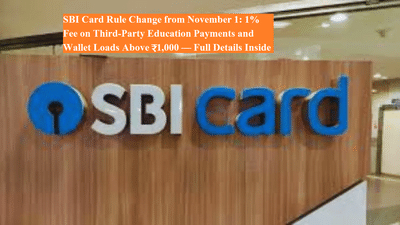Starting November 1, 2025, SBI Card, one of India’s leading credit card issuers, will implement a revised fee structure that directly impacts users who make payments through third-party apps or digital wallets. The company has officially updated its website, outlining new transaction charges, including a 1% fee on education payments made via payment aggregators and on wallet loads exceeding ₹1,000.
Let’s break down what these changes mean for cardholders, how much extra you might pay, and what other fee updates have been announced.
1% Fee on Education Payments via Third-Party AppsFrom November 1, if you pay school, college, or educational institution fees through a third-party app or payment aggregator such as Paytm, PhonePe, Razorpay, or similar platforms, a 1% transaction charge will be applied.
For example:
If a student pays ₹10,000 in fees using one of these apps, an extra ₹100 will be added as a convenience fee.
However, there’s an exception — if you make the payment directly through the institution’s official website or POS machine installed on campus, no additional charge will be levied.
This move appears to encourage users to choose official payment channels over third-party intermediaries, which often add operational costs.
1% Fee on Wallet Load Transactions Above ₹1,000SBI Card has also introduced a 1% fee on wallet reloads exceeding ₹1,000.
For instance:
If you add ₹2,000 to your Paytm Wallet, Amazon Pay, or any similar wallet, you’ll pay ₹20 as an additional fee.
This means cardholders will now need to be cautious about using their credit cards for wallet top-ups, as frequent small transactions could lead to avoidable extra charges.
Updated SBI Card Fee Structure (Effective November 1, 2025)The company has also revised multiple other service charges. Here’s the full updated list for reference:
Cash, Cheque & Dishonour Charges-
Cash payment fee: ₹250
-
Cheque payment fee: ₹200
-
Payment dishonour fee: 2% of the transaction amount (minimum ₹500)
-
Cash advance fee: 2.5% of the withdrawn amount (minimum ₹500) for both domestic and international ATMs
-
Card replacement fee: ₹100–₹250 (for most cards)
-
Aurum Card replacement: ₹1,500
-
Overseas replacement fee: As per actual cost, minimum $175 (Visa) and $148 (Mastercard)
-
₹0–₹500: No charge
-
₹500–₹1,000: ₹400
-
₹1,000–₹10,000: ₹750
-
₹10,000–₹25,000: ₹950
-
₹25,000–₹50,000: ₹1,100
-
Above ₹50,000: ₹1,300
These changes ensure transparency but will require cardholders to plan their transactions wisely to avoid unnecessary fees.
Why Has SBI Card Introduced These Changes?According to industry experts, the decision is aimed at balancing transaction costs incurred by third-party payments and encouraging users to make payments through direct or official platforms.
Third-party apps often involve multiple intermediaries, increasing the overall cost of processing. By imposing this nominal charge, SBI Card likely wants to discourage indirect routes and promote more secure and cost-efficient channels.
What Should Cardholders Do Now?If you frequently use your credit card for educational payments or wallet top-ups, consider these key points:
Use direct payment options such as official school or college websites to avoid the 1% charge.
Limit wallet top-ups using credit cards to amounts under ₹1,000 whenever possible.
Check your monthly statements carefully to track any new charges post-November.
Update your payment methods for recurring expenses to ensure you’re using the most cost-effective route.
This policy change will primarily affect users who rely on third-party payment apps or digital wallets for convenience. For regular card users who make payments directly through official portals, the impact will be minimal.
However, the update signals a broader shift toward rationalizing transaction fees in India’s digital payment ecosystem. As credit card usage continues to grow, financial institutions are likely to adopt more transparent fee structures aligned with actual processing costs.
Bottom LineFrom November 1, 2025, SBI Cardholders must brace for a few extra charges on select digital transactions. The 1% fee on education payments and wallet loads above ₹1,000 might seem small but could add up over time for frequent users.
To stay cost-efficient, make payments directly through official channels and review updated fee structures regularly. With smart planning, you can continue to enjoy the benefits of your SBI Card while minimizing additional expenses.
You may also like

Tennis LIVE: Carlos Alcaraz given attitude warning as Andy Murray lands new role

MP High Court announces Data Processing Assistant vacancy; learn who can apply.

Four Hindus held for 'I Love Muhammad' graffiti in UP temples

ICAI CA exam results will be declared on this day; find out when and how to check them.

NGT seeks report on frequent landslides in North Bengal hills







